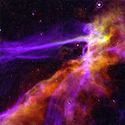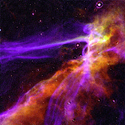A full-flavored neutrino calculation
Supernova explosions caused by the collapse of stellar cores are a vital part of cosmic nucleosynthesis, so researchers would like to better understand how these events occur. One way is to analyze the time evolution of the emitted neutrinos that are copiously generated during the first ten seconds after a star’s collapse. However, neutrinos are chameleons of the particle world—they change identities from one flavor (electron, muon, tau) to another as they pass from the collapsing core to our terrestrial detectors. This makes understanding a neutrino signal exceedingly complex. In a paper in Physical Review Letters, Alexander Friedland at Los Alamos National Laboratory, US, reports new calculations that address some of this complexity head-on.
In contrast to the situation for solar neutrinos, in supernova explosions the density of the streaming neutrinos near the core region is so large that their interactions with each other (“self-refraction”) become important. These interactions lock the oscillating neutrinos of different energies into a collective mode. Instead of dealing with a single-particle evolution problem, one is now presented with a problem of the system evolving as a whole.
Friedland has carried out a calculation of the self-refraction effect several seconds into the explosion—as the collapsed core begins to cool—and shows that a full three-flavor computation reveals new effects. In particular, unusual patterns in the neutrino energy spectrum are seen as one flavor changes into another, and in the antineutrino spectrum a new “mixed” spectrum appears. It will be vital to understand such effects, especially if plans go forward for studying galactic supernovae at a new large neutrino detector at the Deep Underground Science and Engineering Lab in South Dakota. – David Voss





